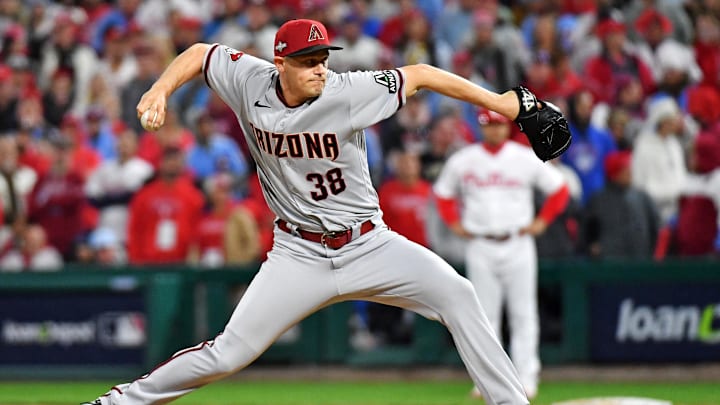The Arizona Diamondbacks’ rotation looks to be one of the best in baseball in 2024. However, while their starting pitchers are the biggest selling point of their pitching staff, don’t sleep on their bullpen. They have a very solid core in the pen, and with how the rotation is built, the D-Backs could win a lot of games by the 7th inning.
As of right now, Paul Sewald is in line to get most of the save opportunities for the D-Backs. Sewald pitched 60.2 innings for the Seattle Mariners and Diamondbacks, posting a 3.12 ERA, 3.57 FIP, and 1.15 WHIP. The right-hander has always been great at striking batters out and had a 32.1% K-rate last year. His 1.19 HR/9 was slightly better than average but had a mediocre 9.6% walk rate. But he could improve upon last season, especially given he was in the 95th percentile of exit velocity (85.9 MPH) and hard-hit rate (29.9%) while sitting in the 83rd percentile of barrel rate (5.6%).
Kevin Ginkel figures to be the set-up man for Sewald. Ginkel had an outstanding breakout season in 2023, pitching to a 2.48 ERA, 2.86 FIP, and 0.98 WHIP through 65.1 innings of work. He had a 27.6% K%, 0.41 HR/9, and a 9.1% walk rate. Although Ginkel wasn’t as good at limiting hard contact as Sewald, he was still good with an 88 MPH exit velocity, 37.1% hard-hit rate, and 7.5% barrel rate. On top of that, he had an outstanding 50.3% ground ball rate, which will play nicely with the Diamondbacks’ strong defensive infield.
Sidearm right-hander Ryan Thompson looks to return to the D-Backs in 2024. The Snakes had acquired Thompson via a minor league deal after the Tampa Bay Rays released him. Although Thompson struggled in Tampa this year, he looked great down the line with the Diamondbacks. He only pitched 13 innings in red and black, but he allowed just one earned run, struck out nine batters, and allowed one walk. He then went on to pitch 11.2 Postseason innings, only allowing three earned runs.
Miguel Castro will likely slot into a middle relief role. Castro did not have super impressive numbers with a 4.31 ERA and FIP, along with a 1.18 WHIP in 64.2 innings. Castro’s 9.3% walk rate was slightly worse than the league average, but both his 22.4% K-rate and 1.11 HR/9 were nearly spot on average. But don’t be fooled by those numbers. Castro had a poor two-game stretch on August 16th and 18th, allowing eight earned runs in 1.1 innings. Outside of these two games, he had a 3.27 ERA and 3.65 FIP. Castro also can take advantage of the D-Backs’ strong defense as he had an 86.1 MPH exit velo (93rd percentile), 28.3% hard-hit rate (98th percentile), and 6.1% barrel rate (80th percentile).
In the way of left-handers, rookie Andrew Saalfrank could secure a high-leverage role if he pitches anything like he did at Triple-A. Saalfrank split his season almost evenly between Reno and Amarillo. In total, he pitched 66.1 innings with a 2.58 ERA, 3.09 FIP, and 1.30 WHIP. Saalfrank did two things very well, and that was striking out batters with a 34.4% K-rate and not allowing home runs with a 0.26 HR/9 and 62.8% GB%. But he did have a mediocre 13.8% BB%.
A few things stand out about Saalfrank’s season. One, he had a sub-2.50 ERA at Triple-A Reno. The league average ERA in the PCL is 5.70 and is one of the most hitter-friendly environments in pro baseball. The second thing is he cut his walk rate down from 14.2% at Dobule-A to just 11.7% at Triple-A. What’s impressive about this is that all Triple-A leagues used the automated strike zone in 2023, and walk rates across Triple-A rose dramatically. His walk rate was 1.5% better than the average. Saalfrank got the call to the big leagues late into the year where he pitched 10.1 scoreless innings, walking three (including an additional one intentionally) and striking out six. He induced a ground ball rate of 71% in the small sample size.
Joe Mantiply looks to be the team’s second left-handed reliever. After an all-star 2022 season, Mantiply followed that up with just a 4.62 ERA, 3.84 FIP, and 1.13 WHIP in 39 innings. Mantiply’s walk rate went up by over double from 2.5% to 5.7% (which is still very good), but saw his K% drop significantly from 25.1% to 17.8%. He was sent to Triple-A at one point, but in his defense, he had a solid end to the year with a 3.86 ERA, 3.64 FIP, and 1.6 WHIP through his final 23.1 innings of the year.
The D-Backs also have some other arms who could round out the rest of their bullpen. Kyle Nelson could be a third lefty out of the pen for Arizona. While Nelson looked good in 2022, he struggled last year. Luis Frias is another potential middle relief arm for the Diamondbacks. Scott McGough is another arm who could see time as a middle reliever in 2024. He had an ERA uner 3.00 in the first half, but over 8.00 in the second half. Ryne Nelson, Humberto Castellanos, or Tommy Henry could serve as a long reliever. Finally, they have some non-roster invitees like Brandon Hughes and Jose Castillo, both of whom were minor league signees, and prospect Austin Pope, who could be in the running for one of the last bullpen spots.
The D-Backs have a solid core to their pen. Sewald, Ginkel, Thompson, Castro, Saalfrank, and Mantiply could all give the Snakes very solid production in important innings. The Diamondbacks already have a strong rotation, and with their bullpen having a solid group of arms, they could be shutting games down by the 7th inning with ease.
